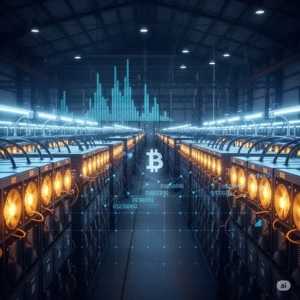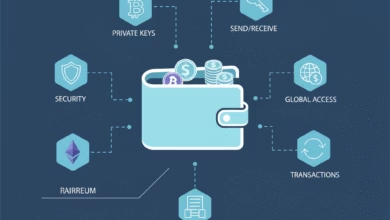Is it worth mining bitcoin in 2025?
Understand what bitcoin mining is and whether it is worth it today

The world of cryptocurrency is constantly evolving, and Bitcoin mining, the process of verifying and adding new transactions to the Bitcoin blockchain, remains a hot topic. If you’re wondering whether diving into Bitcoin mining in 2025 is a worthwhile venture, you’ve come to the right place. This article will break down the complexities of Bitcoin mining profitability, considering the technological advancements and economic factors at play, all in an easy-to-understand manner.
Understanding Bitcoin Mining: How it Works and Why it Matters for Cryptocurrency

At its core, Bitcoin mining involves powerful computers solving complex mathematical problems. This process verifies transactions and secures the Bitcoin network. In return for their efforts, miners are rewarded with newly minted Bitcoins and transaction fees. This is how new Bitcoins enter circulation and how the network remains decentralized and secure. However, the landscape of Bitcoin mining has changed significantly since its early days.
Factors Influencing Bitcoin Mining Profitability in the Coming Years
Deciding whether to invest in Bitcoin mining hardware in 2025 requires a careful evaluation of several key factors that directly impact profitability:
The Ever-Increasing Bitcoin Mining Difficulty: A Major Hurdle
As more miners join the Bitcoin network, the computational difficulty of solving the mining puzzles increases. This means that more powerful and energy-efficient hardware is required to remain competitive. In 2025, the Bitcoin mining difficulty is expected to be significantly higher than in previous years, demanding substantial processing power.
Fluctuations in Bitcoin Price: A High-Volatility Factor
The profitability of Bitcoin mining is directly tied to the price of Bitcoin. If the price of Bitcoin rises, mining becomes more profitable, and vice versa. The cryptocurrency market is known for its volatility, making it challenging to predict future Bitcoin price movements accurately. Any investment in mining hardware carries the risk of price downturns impacting your returns.
The Cost of Electricity: A Significant Operational Expense for Miners

Bitcoin mining is an energy-intensive process. The electricity costs associated with running powerful mining equipment can be substantial, often representing the largest operational expense. The profitability of mining heavily depends on the price of electricity in your location. Regions with cheap electricity offer a significant advantage to miners.
Advancements in Mining Hardware: The Efficiency Race
The technology behind Bitcoin mining hardware, primarily ASIC (Application-Specific Integrated Circuit) miners, is constantly improving. Newer generations of ASICs are more energy-efficient and offer higher hash rates (the speed at which they can perform calculations). Investing in outdated hardware in 2025 would likely result in lower efficiency and reduced profitability compared to the latest models.
Is Bitcoin Mining in 2025 Right for You? Considerations for Potential Miners

Before jumping into Bitcoin mining in 2025, consider the following crucial questions:
Access to Affordable Electricity: A Non-Negotiable Requirement
Evaluate the cost of electricity in your area. High electricity prices can quickly eat into any potential mining profits, making the operation unsustainable. Research the average industrial or commercial electricity rates in your region to get a realistic estimate of your potential expenses.
Initial Investment in Mining Hardware: A Significant Upfront Cost
The latest generation ASIC miners can be expensive. Calculate the upfront cost of purchasing the hardware, considering factors like hash rate, energy efficiency, and availability. Factor in potential shipping costs and import duties as well.
Cooling and Infrastructure: Maintaining Optimal Operating Conditions

Bitcoin mining hardware generates significant heat. You’ll need a proper cooling system and adequate infrastructure to ensure your equipment operates efficiently and doesn’t overheat, which can lead to damage and downtime. Consider the costs associated with ventilation, cooling fans, or even immersion cooling setups.
Noise Levels: A Potential Issue for Residential Mining
ASIC miners can be very noisy. If you plan to mine from a residential location, consider the noise levels and whether they will be disruptive to you or your neighbors. Soundproofing measures might be necessary, adding to your overall costs.
Competition and Mining Pools: Navigating the Mining Ecosystem
The Bitcoin mining landscape is highly competitive. Individual miners with limited resources often join mining pools, which combine their computing power and share the rewards. Understand how mining pools work and the fees they charge. Solo mining with limited hash power in 2025 is generally not profitable.
The Verdict: Evaluating Bitcoin Mining Profitability in 2025
In conclusion, Bitcoin mining in 2025 is likely to be a more challenging and capital-intensive endeavor than in the past. While potential profits still exist, they are heavily dependent on factors like the price of Bitcoin, electricity costs, the efficiency of your hardware, and the increasing mining difficulty.

For the average individual, large-scale Bitcoin mining operations in regions with very cheap electricity often hold a significant advantage. Before investing, conduct thorough research, calculate potential costs and returns meticulously, and understand the risks involved in the volatile cryptocurrency market. For most people, exploring other avenues within the cryptocurrency space might be a more accessible and less energy-intensive option.





